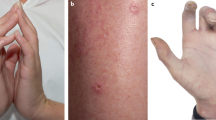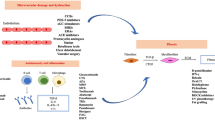Abstract
Skin tightness is a major clinical manifestation of systemic sclerosis (SSc). Importantly for both clinicians and patients, spontaneous regression of the fibrosis process has been documented. The purpose of this study is to identify the incidence and related clinical characteristics of spontaneous regression among Thai SSc patients. A historical cohort with 4 years of follow-up was performed among SSc patients over 15 years of age diagnosed with SSc between January 1, 2005 and December 31, 2006 in Khon Kaen, Thailand. The start date was the date of the first symptom and the end date was the date of the skin score ≤2. To estimate the respective probability of regression and to assess the associated factors, the Kaplan–Meier method and Cox regression analysis was used. One hundred seventeen cases of SSc were included with a female to male ratio of 1.5:1. Thirteen patients (11.1%) experienced regression. The incidence rate of spontaneous skin regression was 0.31 per 100 person-months and the average duration of SSc at the time of regression was 35.9 ± 15.6 months (range, 15.7–60 months). The factors that negatively correlated with regression were (a) diffuse cutaneous type, (b) Raynaud’s phenomenon, (c) esophageal dysmotility, and (d) colchicine treatment at onset with a respective hazard ratio (HR) of 0.19, 0.19, 0.26, and 0.20. By contrast, the factor that positively correlated with regression was active alveolitis with cyclophosphamide therapy at onset with an HR of 4.23 (95% CI, 1.23–14.10). After regression analysis, only Raynaud’s phenomenon at onset and diffuse cutaneous type had a significantly negative correlation to regression. A spontaneous regression of the skin fibrosis process was not uncommon among Thai SSc patients. The factors suggesting a poor predictor for cutaneous manifestation were Raynaud’s phenomenon, diffuse cutaneous type while early cyclophosphamide therapy might be related to a better skin outcome.



Similar content being viewed by others
References
Mayes MD, Lacey JV, Beebe-Dimmer J et al (2003) Prevalence, incidence, survival, and disease characteristics of systemic sclerosis in a large US population. Arthritis Rheum 48(8):2246–2255
Silman AJ (1997) Scleroderma—demographics and survival. J Rheumatol Suppl 48:58–61
Steen VD, Oddis CV, Conte CG, Janoski J, Casterline GZ, Medsger TA (1997) Incidence of systemic sclerosis in Allegheny County, Pennsylvania. A twenty-year study of hospital-diagnosed cases, 1963–1982. Arthritis Rheum 40(3):441–445
Czirják L, Foeldvari I, Müller-Ladner U (2008) Skin involvement in systemic sclerosis. Rheumatology (Oxford) 47(Suppl 5):v44–v45
Brennan P, Silman A, Black C et al (1992) Reliability of skin involvement measures in scleroderma. The UK Scleroderma Study Group. Br J Rheumatol 31(7):457–460
Black CM (1995) Measurement of skin involvement in scleroderma. J Rheumatol 22(7):1217–1219
Verrecchia F, Laboureau J, Verola O et al (2007) Skin involvement in scleroderma—where histological and clinical scores meet. Rheumatology (Oxford) 46(5):833–841
Furst DE, Clements PJ, Steen VD et al (1998) The modified Rodnan skin score is an accurate reflection of skin biopsy thickness in systemic sclerosis. J Rheumatol 25(1):84–88
Furst DE (2008) Outcome measures in rheumatologic clinical trials and systemic sclerosis. Rheumatology (Oxford) 47(Suppl 5):v29–v30
Pope JE, Bellamy N (1993) Outcome measurement in scleroderma clinical trials. Semin Arthritis Rheum 23(1):22–33
Matsushita T, Hasegawa M, Hamaguchi Y, Takehara K, Sato S (2006) Longitudinal analysis of serum cytokine concentrations in systemic sclerosis: association of interleukin 12 elevation with spontaneous regression of skin sclerosis. J Rheumatol 33(2):275–284
Anonymous (1980) Preliminary criteria for the classification of systemic sclerosis (scleroderma). Subcommittee for scleroderma criteria of the American Rheumatism Association Diagnostic and Therapeutic Criteria Committee. Arthritis Rheum 23(5):581–590
LeRoy EC, Black C, Fleischmajer R et al (1988) Scleroderma (systemic sclerosis): classification, subsets and pathogenesis. J Rheumatol 15(2):202–205
Panicheewa S, Chitrabamrung S, Verasertniyom O et al (1991) Diffuse systemic sclerosis and related diseases in Thailand. Clin Rheumatol 10(2):124–129
Vancheeswaran R, Azam A, Black C, Dashwood MR (1994) Localization of endothelin-1 and its binding sites in scleroderma skin. J Rheumatol 21(7):1268–1276
Vancheeswaran R, Magoulas T, Efrat G et al (1994) Circulating endothelin-1 levels in systemic sclerosis subsets—a marker of fibrosis or vascular dysfunction? J Rheumatol 21(10):1838–1844
Sunderkotter C (2006) Pathophysiology and clinical consequences of Raynaud’s phenomenon related to systemic sclerosis. Rheumatology 45(Supplement 3):iii33–iii35
Wang R, Ghahary A, Shen YJ, Scott PG, Tredget EE (1997) Nitric oxide synthase expression and nitric oxide production are reduced in hypertrophic scar tissue and fibroblasts. J Invest Dermatol 108(4):438–444
Knock GA, Terenghi G, Bunker CB, Bull HA, Dowd PM, Polak JM (1993) Characterization of endothelin-binding sites in human skin and their regulation in primary Raynaud’s phenomenon and systemic sclerosis. J Invest Dermatol 101(1):73–78
Calguneri M, Apras S, Ozbalkan Z et al (2003) The efficacy of oral cyclophosphamide plus prednisolone in early diffuse systemic sclerosis. Clin Rheumatol 22(4–5):289–294
Apras S, Ertenli I, Ozbalkan Z et al (2003) Effects of oral cyclophosphamide and prednisolone therapy on the endothelial functions and clinical findings in patients with early diffuse systemic sclerosis. Arthritis Rheum 48(8):2256–2261
Caramaschi P, Canestrini S, Martinelli N et al (2007) Scleroderma patients nailfold videocapillaroscopic patterns are associated with disease subset and disease severity. Rheumatology 46(10):1566–1569
Acknowledgments
We thank the Faculty of Medicine for its support and Mr. Bryan Roderick Hamman and Mrs. Janice Loewen-Hamman for the assistance with the English language presentation of the manuscript.
Disclosures
None.
Author information
Authors and Affiliations
Corresponding author
Additional information
An erratum to this article can be found at http://dx.doi.org/10.1007/s10067-011-1817-z
Rights and permissions
About this article
Cite this article
Foocharoen, C., Mahakkanukrauh, A., Suwannaroj, S. et al. Spontaneous skin regression and predictors of skin regression in Thai scleroderma patients. Clin Rheumatol 30, 1235–1240 (2011). https://doi.org/10.1007/s10067-011-1744-z
Received:
Revised:
Accepted:
Published:
Issue Date:
DOI: https://doi.org/10.1007/s10067-011-1744-z




